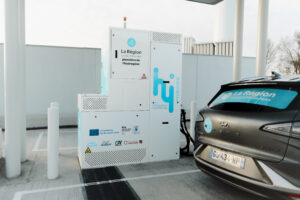For many cities, overcrowded buses and poor data on passenger movements make it difficult to deliver reliable, comfortable public transport. But for Pawan Seshadri Venkatesh and Ivo de Geus, these challenges became the starting point of a journey – one that began in the EIT Urban Mobility Master School and led them to launch their own startup, UrbanVind.
The Netherlands-based company’s solution, CrowdFlow, is currently being piloted and deployed in Latvia, Türkiye and Portugal. While the startup continues to evolve, the real story is how the co-founders turned their shared academic experience into a mission to improve sustainable urban transport through better data.
From automotive engineering to systems thinking
“I thought the courses in the EIT Urban Mobility Master School were spot on because I wanted to see sustainable mobility more from a holistic perspective than purely from an automotive perspective,” said Venkatesh, who came to the programme with a background in automotive engineering.
The two-year Sustainable Urban Mobility Transitions Master School programme exposes students to leading universities, industry experts and real-world mobility challenges, with a strong emphasis on entrepreneurship. For Venkatesh, it was a “double bonus” for its combined focus on sustainability and startup thinking.
“They teach a lot about how to identify problems, how to validate problems, and then how to create solutions and business models,” he said.
It was during an EIT Urban Mobility Summer School at the Polytechnic University of Milan that Venkatesh and de Geus first teamed up to tackle a mobility challenge presented by a major rail company: how to deal with overcrowding on public transport. That experience planted the seed for what would eventually become CrowdFlow.
Learning through doing
After graduation, the pair stayed in touch, drawing on the network and skills they built during their time at the Master School to develop their idea further. Their continued engagement with EIT Urban Mobility – particularly through the 2024 Accelerate2MOVE programme – played a key role in pushing their solution forward.
“The accelerator programme was also really helpful for us just to meet other startups and see where they’re at and they also really helped us get in touch with more cities and investors,” Venkatesh said.

Their solution, CrowdFlow, was developed as a direct result of customer discovery process, listening to what public transport operators really needed. “We spoke to I think 30 or 40 potential customers, and we started hearing the same things repeated: ‘We don’t have data, we don’t have data, we need a better system for data,’” Venkatesh recalled.
Startup grounded in real needs
UrbanVind’s CrowdFlow addresses these data gaps with a cost-effective system that delivers real-time insights into crowding and passenger travel patterns. Depending on the setup, it can run on a plug-and-play box or a bus driver’s work phone.
By detecting Bluetooth Low-Energy signals from passengers’ mobile devices as they board and exit, CrowdFlow estimates passenger numbers and captures anonymised origin–destination data, valuable information that helps cities make smarter, data-driven transport decisions.
In Antalya, Türkiye and Jūrmala, Latvia, two EIT Urban Mobility-supported pilots are planned, with others following in Lisbon and Sweden. These pilots are helping validate the product and fine-tune it for different markets.
“These cities rely on mobility staff who are forward-looking and have this innovation in mind. They are the ones that are pushing for these kinds of projects and they’re fantastic people to work with,” said de Geus.
“They have been extremely supportive, and they understand the potential of the product that we are building together, so they have been very patient and supportive with continuous feedback to help us improve,” added Venkatesh.
A future built on skills and networks
UrbanVind is now exploring ways to integrate CrowdFlow data into passenger-facing tools like GoogleMaps or municipal transport apps, so riders can make real-time decisions to avoid overcrowding while also exploring how it can further help Transport Planners. In the longer term, they see their data becoming vital for future systems like demand-responsive transit and autonomous buses.
“When you look into the future of public transport, they are not going to be static bus lines with static schedules, they are also going to be demand-responsive transit systems,” said Venkatesh. “That’s where I think our data could be really valuable.”
The journey of UrbanVind is still in its early stages – but it all started with entrepreneurial education and hands-on experience that enabled the development of turned learning into real-world impact.




